PyTorch
Working with Data
Datasets and Dataloaders
Data is the cornerstone of any machine learning or AI project. The quality and organization of your data have a direct impact on model performance. High-quality, well-organized data enables your model to learn meaningful patterns rather than noise, thereby enhancing its ability to generalize to new, unseen data.
In this lesson, we explore how PyTorch’s Datasets and Dataloaders provide powerful tools for efficient data handling and loading.
![]()
Overview
In PyTorch, a Dataset represents your data (whether images, text, or any other forms), while a Dataloader wraps an iterable around the dataset, enabling efficient access to data samples. Together, they simplify tasks like batching, shuffling, and parallel data loading, thereby streamlining the training process.
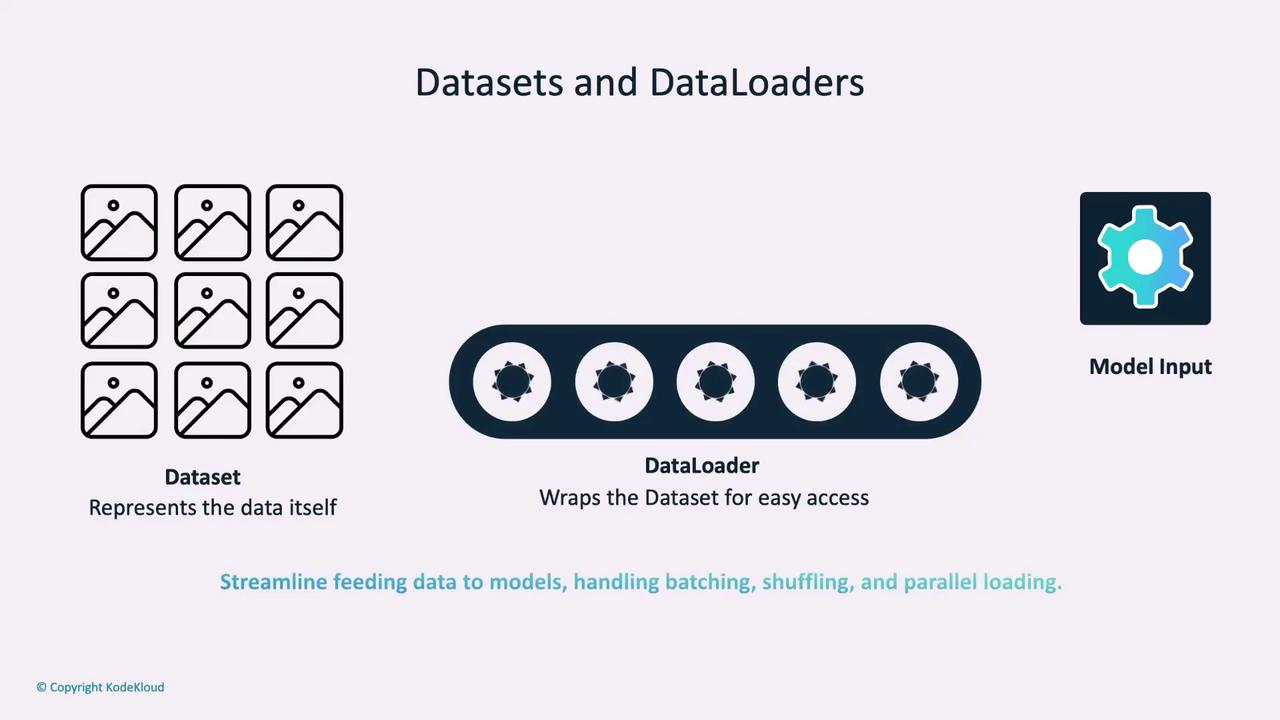
Efficient data access and processing patterns are key to improving training performance. Datasets and dataloaders not only abstract the data-handling process but also optimize the training loops.
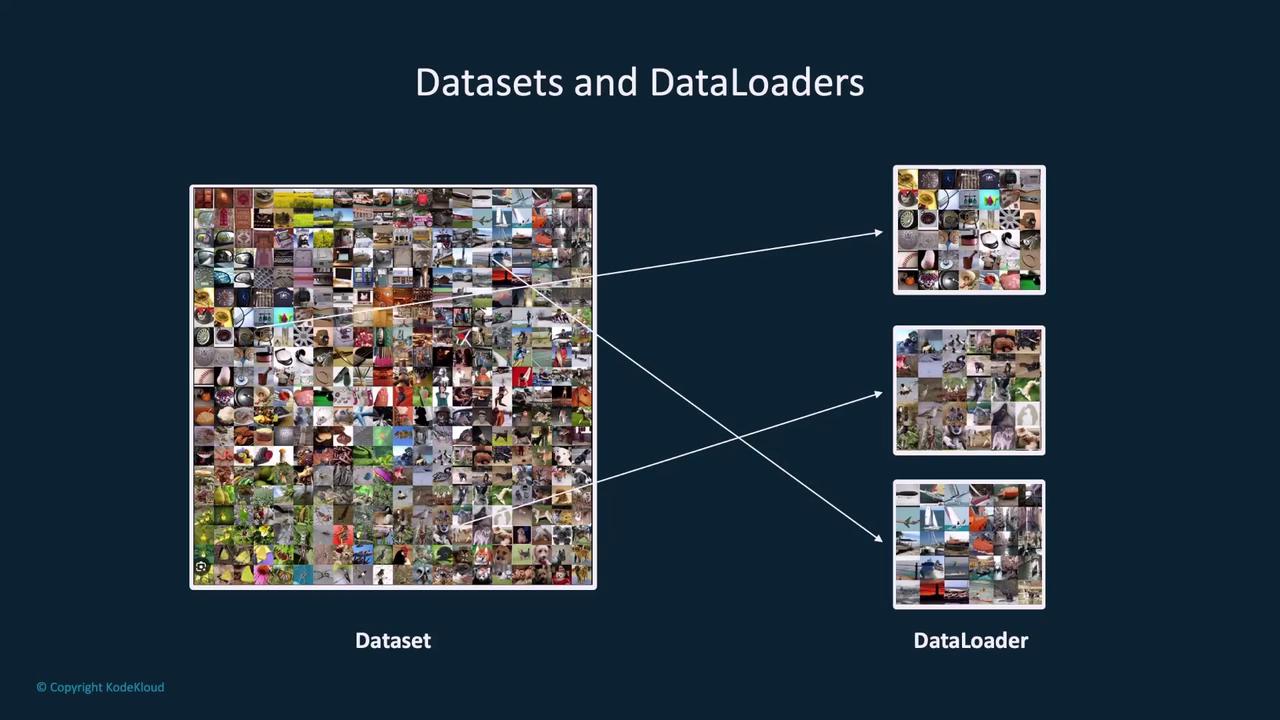
PyTorch Datasets
Datasets in PyTorch are typically implemented using a Python class that serves as a blueprint for accessing and processing data samples. This approach allows you to customize data handling for various types of inputs.
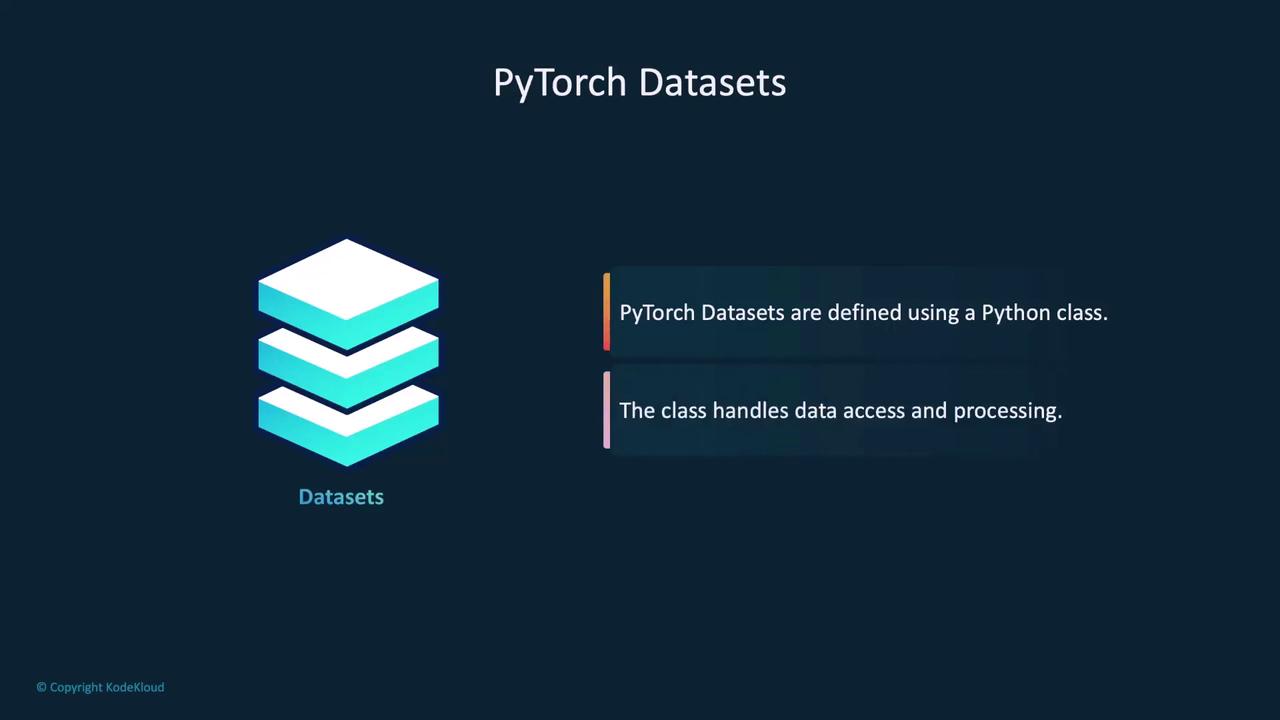
The Dataset class is built around three key methods:
__init__: Initializes the dataset object. Here you define the dataset source (e.g., a local directory, annotation file) and specify any transformations to be applied.__len__: Returns the total number of samples in your dataset.__getitem__: Retrieves a specific data sample based on the index, supporting indexed access similar to Python lists or arrays.

Below is an example showcasing a custom PyTorch dataset class called CustomImageDataset:
import os
import pandas as pd
from torchvision.io import read_image
from torch.utils.data import Dataset
class CustomImageDataset(Dataset):
def __init__(self, annotations_file, img_dir, transform=None, target_transform=None):
self.img_labels = pd.read_csv(annotations_file)
self.img_dir = img_dir
self.transform = transform
self.target_transform = target_transform
def __len__(self):
return len(self.img_labels)
def __getitem__(self, idx):
img_path = os.path.join(self.img_dir, self.img_labels.iloc[idx, 0])
image = read_image(img_path)
label = self.img_labels.iloc[idx, 1]
if self.transform:
image = self.transform(image)
if self.target_transform:
label = self.target_transform(label)
return image, label
In this example, the __init__ method reads an annotation CSV file containing image filenames and labels. The image directory and optional transformations are stored for later use. The __len__ method returns the number of samples, while __getitem__ constructs the image path, reads the image into a tensor, applies the necessary transformations, and returns both image and label as a tuple.
There are two main categories of datasets in PyTorch:
- Preloaded Datasets: Ready-to-use datasets provided by PyTorch for popular data sources.
- Custom Datasets: Custom-built datasets tailored to your unique data requirements.

Understanding how to implement and utilize the Dataset class allows you to manage various data types while customizing data access and preprocessing techniques.
Creating a Custom Dataset
Creating a custom dataset in PyTorch is straightforward. The flexibility offered by custom datasets lets you tailor data handling to your specific project requirements. Consider the following minimal example:
import torch
from torch.utils.data import Dataset
class CustomDataset(Dataset):
def __init__(self):
# Initialize data
self.data = [] # Replace with your data loading logic
def __len__(self):
return len(self.data)
def __getitem__(self, idx):
sample = self.data[idx]
return sample # Return a data sample
In this simplified example, __init__ loads your data, __len__ returns the total number of samples, and __getitem__ retrieves a sample based on its index.
Depending on your project, you might need to load different data types. Here are examples for images, text, and audio:
Loading Image Data
from PIL import Image
from torch.utils.data import Dataset
class ImageDataset(Dataset):
def __init__(self, image_paths):
self.image_paths = image_paths # List of image file paths
def __len__(self):
return len(self.image_paths)
def __getitem__(self, idx):
image = Image.open(self.image_paths[idx]) # Open image file
return image # Return the image
Loading Text Data
from torch.utils.data import Dataset
class TextDataset(Dataset):
def __init__(self, text_files):
self.text_files = text_files # List of text file paths
def __len__(self):
return len(self.text_files)
def __getitem__(self, idx):
with open(self.text_files[idx], 'r') as file:
text = file.read() # Read text file content
return text # Return the text data
Loading Audio Data
import torchaudio
from torch.utils.data import Dataset
class AudioDataset(Dataset):
def __init__(self, audio_files):
self.audio_files = audio_files # List of audio file paths
def __len__(self):
return len(self.audio_files)
def __getitem__(self, idx):
waveform, sample_rate = torchaudio.load(self.audio_files[idx]) # Load audio file
return waveform # Return the audio data
Preloaded Datasets in PyTorch
PyTorch includes a variety of preloaded datasets that are widely used in machine learning and AI tasks. These datasets are preprocessed and ready to use, saving you valuable time during experimentation. For instance, vision datasets are accessible via the TorchVision library, offering popular datasets like MNIST, CIFAR-10, and ImageNet.
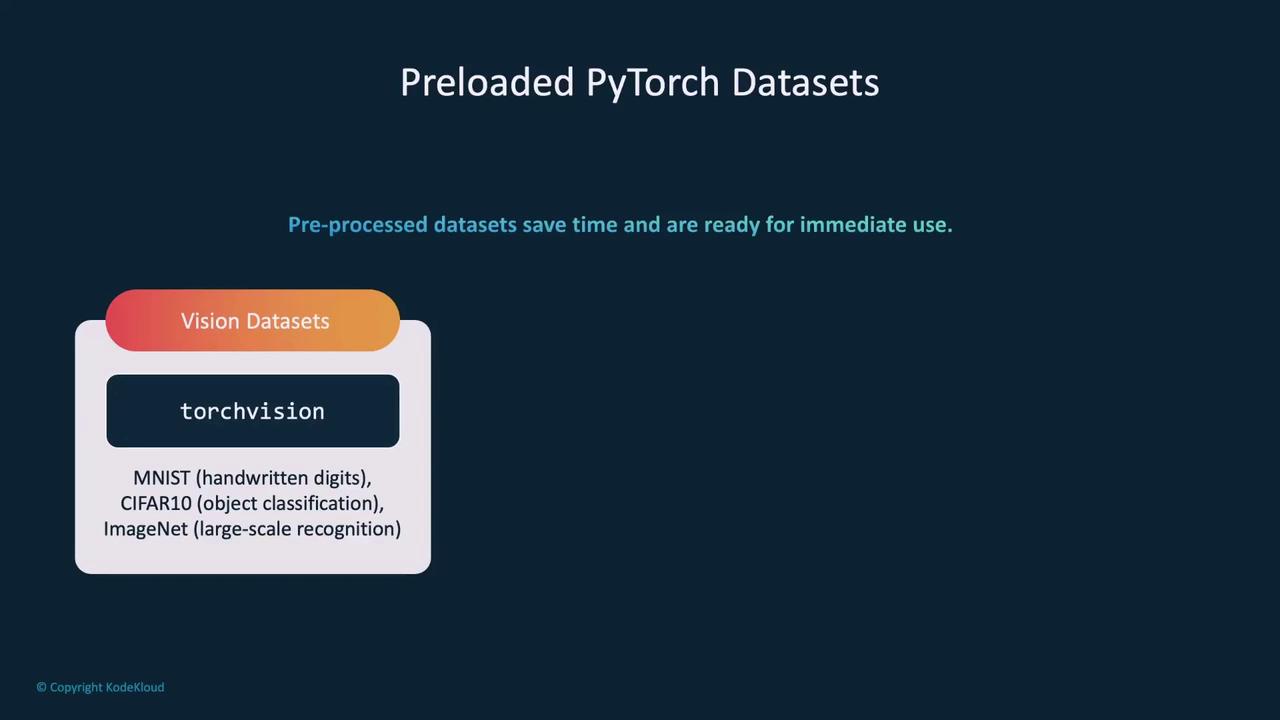
Text tasks benefit from the TorchText library, and audio processing tasks often leverage TorchAudio, both of which include several preloaded datasets.
Example: Loading the MNIST Dataset
The MNIST dataset is a classic example in the machine learning community, containing 70,000 images of handwritten digits. Using TorchVision, loading MNIST is straightforward:
from torchvision import datasets
train_dataset = datasets.MNIST(root='data/', train=True, download=True)
print(train_dataset)
# Output:
# Dataset MNIST
# Number of datapoints: 60000
# Root location: data/
# Split: Train
By setting train=True, you load the training set; similarly, switching to train=False provides the test set. Each sample in the dataset is a tuple consisting of a 28x28 grayscale image and its corresponding label (a digit between 0 and 9).
Accessing individual samples is as simple as:
image, label = train_dataset[0]
print(f'Label: {label}')
print(f'Image size: {image.size}')
This method of accessing data is consistent with both preloaded and custom datasets.
Dataloaders in PyTorch
Dataloaders serve as an iterable wrapper around a dataset, making it easier to loop through data samples during training. They are especially useful for handling batching, shuffling, and parallel data loading using multiple workers.
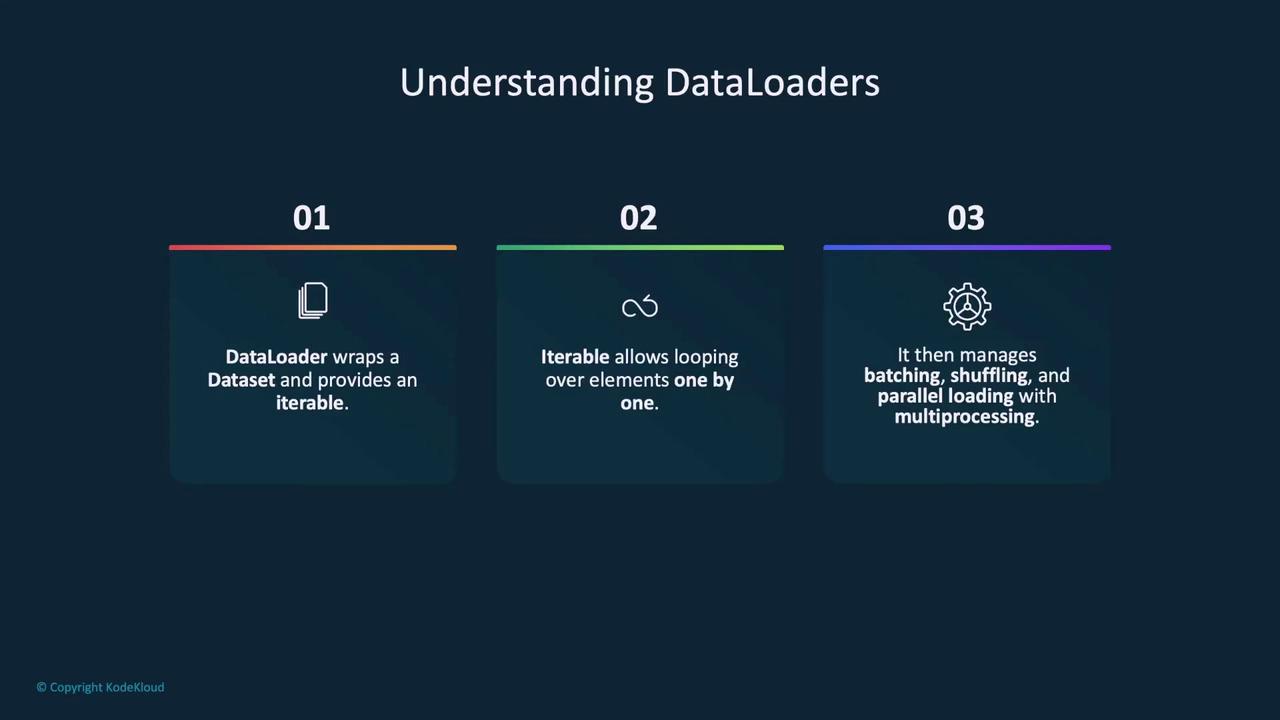
When importing a Dataloader from torch.utils.data, you can configure key parameters:
- batch_size: Specifies how many samples are loaded in each batch. Larger batches speed up training but require more memory.
- shuffle: If set to
True, randomizes the order of data samples each epoch, which can improve model generalization. - num_workers: Determines the number of subprocesses to use for data loading. Increasing this number can boost data loading speed but consumes more CPU resources.
For example, creating a dataloader for the MNIST training dataset looks like this:
from torch.utils.data import DataLoader
train_loader = DataLoader(dataset=train_dataset,
batch_size=64,
shuffle=True,
num_workers=2)
Tip
Remember to adjust the batch_size and num_workers parameters according to your hardware capabilities for optimal performance.
Summary
Datasets and Dataloaders are fundamental building blocks in PyTorch that simplify data management for model training. Preloaded datasets provide a quick starting point for many applications, while custom datasets offer the flexibility needed for specialized data sources. By fine-tuning settings such as batch size, shuffling, and the number of worker processes, you can significantly optimize both data loading and the overall training process.
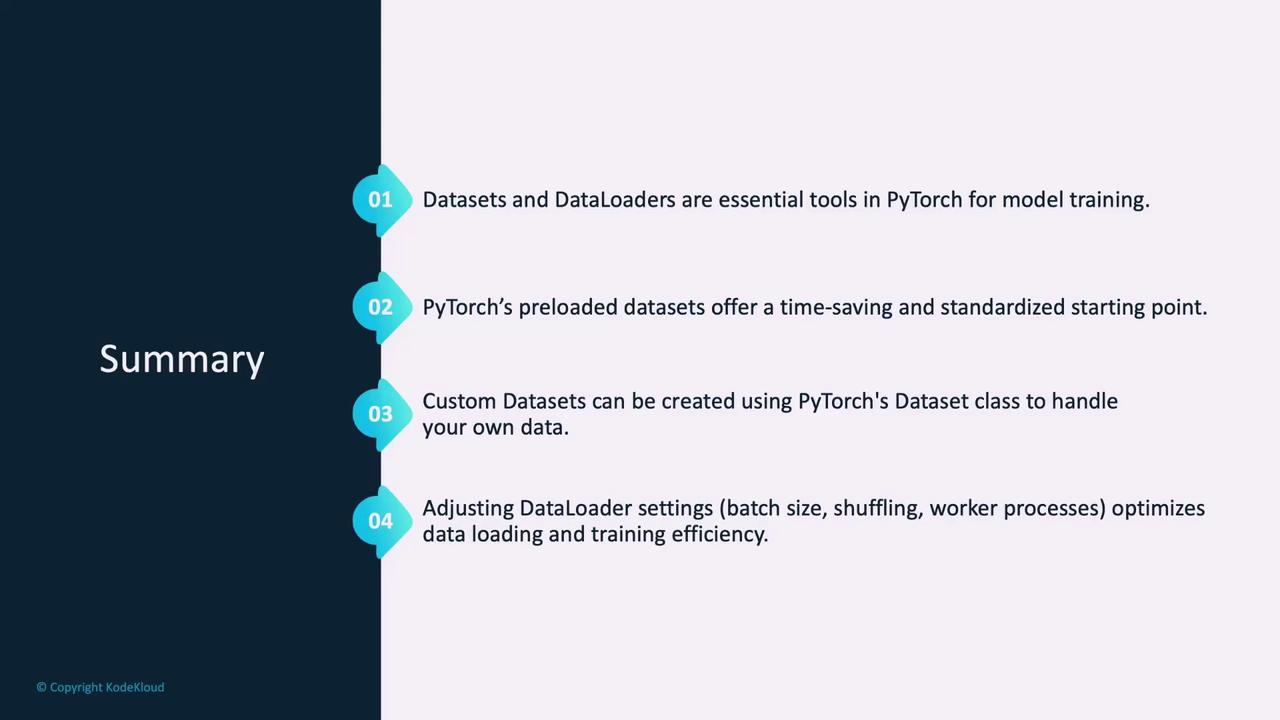
Now that you have a clear understanding of PyTorch's Datasets and Dataloaders, let's proceed to a demo to see these concepts in action.
Watch Video
Watch video content